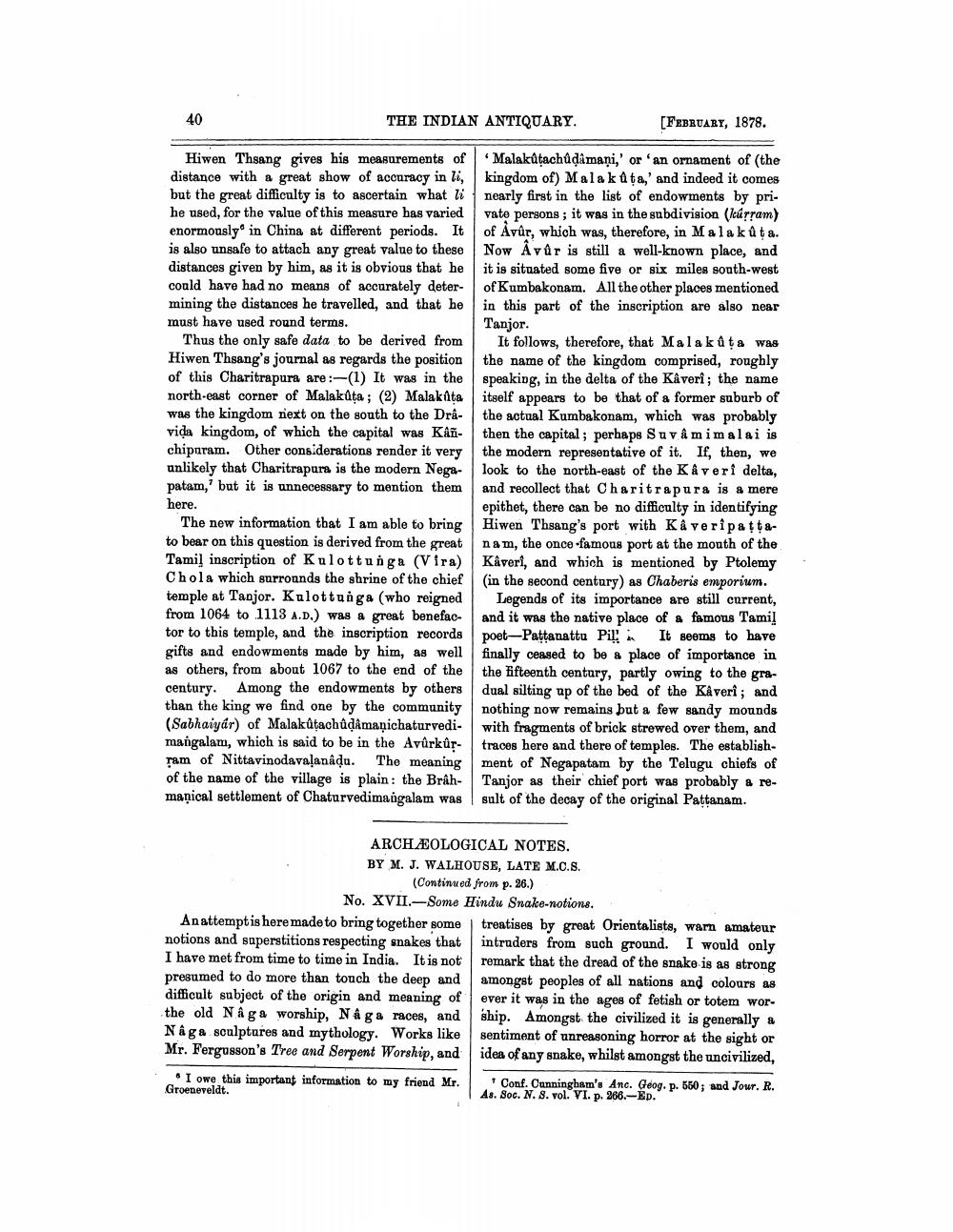________________
THE INDIAN ANTIQUARY.
[FEBRUARY, 1878.
Hiwen Thsang gives his measurements of Malakútachudamani,' or 'an ornament of the distance with a great show of accuracy in li, kingdom of) Mala kata,' and indeed it comes but the great difficulty is to ascertain what linearly first in the list of endowments by prihe used, for the value of this measure has varied vate persons; it was in the subdivision (kúrram) enormously in China at different periods. It of Avûr, which was, therefore, in Mala kûta. is also unsafe to attach any great value to these Now Avûr is still a well-known place, and distances given by him, as it is obvious that he it is situated some five or six miles south-west could have had no means of accurately deter- of Kumbakonam. All the other places mentioned mining the distances he travelled, and that he in this part of the inscription are also near must have used round terms.
Tanjor. Thus the only safe data to be derived from It follows, therefore, that Malakata was Hiwen Thsang's journal as regards the position the name of the kingdom comprised, roughly of this Charitrapura are:-(1) It was in the speaking, in the delta of the Kaveri ; the name north-east corner of Malakūta; (2) Malakata itself appears to be that of a former suburb of was the kingdom next on the south to the Dra- the actual Kumbakonam, which was probably vida kingdom, of which the capital was Káñ- then the capital; perhaps Suvâ mimalai is chipuram. Other considerations render it very the modern representative of it. If, then, we unlikely that Charitrapura is the modern Nega- look to the north-east of the K& veri delta, patam,' but it is unnecessary to mention them and recollect that Charitrapura is a mere here.
epithet, there can be no difficulty in identifying The new information that I am able to bring Hiwen Thsang's port with Ka veripattato bear on this question is derived from the great nam, the once-famous port at the mouth of the Tamil inscription of Kulottunga (Vira) Kaveri, and which is mentioned by Ptolemy Chola which surrounds the shrine of the chief (in the second century) as Chaberis emporium. temple at Tanjor. Kulottunga (who reigned Legends of its importance are still current, from 1064 to 1113 A.D.) was a great benefac- and it was the native place of a famous Tami! tor to this temple, and the inscription records poet-Pattanattu Pill It seems to have gifts and endowments made by him, as well finally ceased to be a place of importance in as others, from about 1067 to the end of the the fifteenth century, partly owing to the gracentury. Among the endowments by others dual silting up of the bed of the Kaveri ; and than the king we find one by the community nothing now remains but a few sandy mounds (Sabhaiyar) of Malakútachûdâmaņichaturvedi- with fragments of brick strewed over them, and mangalam, which is said to be in the Avůrkûr- traces here and there of temples. The establishsam of Nittavinodavalanadu. The meaning ment of Negapatam by the Telugu chiefs of of the name of the village is plain: the Brah- Tanjor as their chief port was probably a remaņical settlement of Chaturvedimangalam was sult of the decay of the original Pattanam.
ARCHÆOLOGICAL NOTES. BY M. J. WALHOUSE, LATE M.C.S.
(Continued from p. 26.)
No. XVII.-Some Hindu Snake-notions. An attempt is here made to bring together some treatises by great Orientalists, warn amateur notions and superstitions respecting snakes that intruders from such ground. I would only I have met from time to time in India. It is not remark that the dread of the snake is as strong presumed to do more than touch the deep and amongst peoples of all nations and colours as difficult subject of the origin and meaning of ever it was in the ages of fetish or totem worthe old Naga worship, Nág a races, and ship. Amongst the civilized it is generally & Nâga soulptures and mythology. Works like sentiment of unreasoning horror at the sight or Mr. Fergusson's Tree and Serpent Worship, and idea of any snake, whilst amongst the uncivilized,
I owe this important information to my friend Mr. Groeneveldt.
Conf. Cunningham's Anc. Geog. p. 560; and Jour. R. As. Soc. N. 8. vol. VI. p. 266.- Ep.




